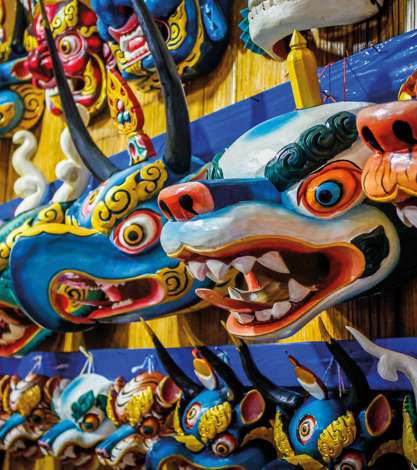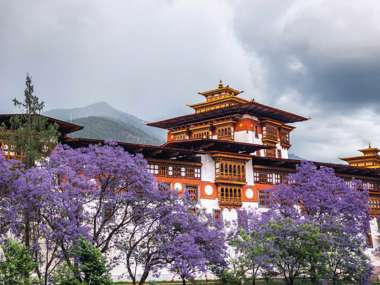Escorted Tours to Bhutan
The Essence of Bhutan
Monasteries cling to mountain ledges; hiking tracks twist among forests and fauna, safeguarded by a Buddhist ethos of conservation; and the local lifestyle balances cultural traditions with careful use of technology. Bhutan is a mindful, Himalayan heaven.
Why Choose a Tour in Bhutan?
Tucked in the eastern Himalayas, Bhutan is known for its glorious scenery, gilded temples and beguiling towns, but what makes it unique is its philosophy, permeating every aspect of daily life.
This is a country rooted in Buddhism and steeped in an air of spirituality, where all life is sacred, and well-being outranks wealth; where age-old traditions are still upheld, and the use of modern technology is tempered to protect the ‘Happiness quotient’ of the population.
Nature is similarly preserved, not least by a law which ensures that at least 60% of the landscape remains forested for future generations. The result is that flora and fauna flourish, from orchids and rhododendrons to 770 species of birdlife, and tigers, snow leopards, black bears, and golden langur among the resident wildlife.
The kingdom’s capital is Thimphu, where modern life is lived within a blend of ancient temples and astonishing statuary, old-world crafts and customs, internet cafés, and vibrant energy. The enchanting little city is the country’s traffic hub, but perhaps the world’s only capital without traffic lights, and it exemplifies the culture of contemporary Bhutan.
The previous seat of government was Punakha, a peaceful little town now, loaded with legends, set at the meeting point of two rivers, and focused on the fortress ‘Palace of Great Joy’, which oversees a serene landscape, little changed in the last six centuries.
A broad and tranquil valley is the scenic setting for Paro, with pastel-painted modern housing and traditional timber buildings. The valley boasts Bhutan’s oldest temple, built in the 7th century; and its most famous Buddhist monastery, the Taksang Goemba (Tiger’s Nest), clinging to its precarious cliff-face perch.
Our journeys in Bhutan are teamed with time in Kolkata and Kathmandu.
When to go on Bhutan Holidays
The countrys climate varies greatly by altitude, sub-tropical in the lowlands, becoming progressively colder the higher the lie of the land. From October to April, daytime temperatures range between 19 and 26° around Punakha, at 1,300 metres; but are generally four degrees lower in Thimphu, a thousand metres higher.
Jules Verne tours are planned for these generally warm and dry months, avoiding the June to September monsoon season.
Who are Bhutan Tours Suited To?
Bhutan has adopted a cautious approach to tourism, to avoid any negative impact on its culture and environment, so its relatively few visitors are rewarded with a unique and absorbing experience of the country’s character, creed, and natural assets. Jules Verne’s small-group tours are an excellent match for Bhutan’s unhurried pace and uncrowded peace.
While most sites can be comfortably visited on foot, some include inclines and uneven surfaces, and a fair level of fitness is required to reach the Tiger’s Nest monastery.
Why Book Bhutan Tours with Jules Verne?
With 45 years’ experience and a passion for creating extraordinary adventures, Jules Verne takes you to iconic landmarks and lesser-known sites, with expert tour guides who share their local knowledge, and show you hidden gems. Our journeys in Bhutan take in the ‘dzong’ forts and ‘chorten’ Buddhist shrines; institutes of herbal medicine, traditional crafts and technical skills; museums of cultural and religious heritage; and an eye-opening journey over the high Dochula Pass.
Our guided tours to Bhutan are ABTA and ATOL-protected, and we offer a 100% price guarantee, so you can book with complete confidence.
Bhutan & The Himalayas
A tour of temples, citadels, mountains and valleys, exploring the happy Himalayan heaven that is the Kingdom of Bhutan, and the legendary friendliness of Nepal



